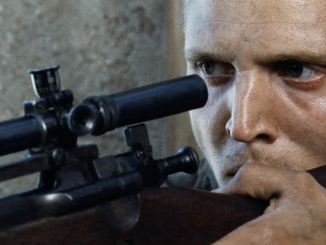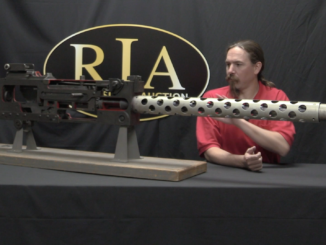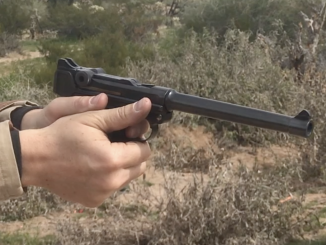The Gibbs carbine is fantastic illustration of just how difficult it can be to actually manufacture a new firearm. The gun itself is a breechloading, percussion fired cavalry carbine designed to use paper cartridges. It was patented in 1856 by Lucien Gibbs, and he was joined by financier William Brooks and gunsmith WW Marston to create a company to produce them. Marston made 20 examples by hand in 1857, and one of these was used in a successful demonstration at West Point in 1858. This led to a contract for 10,000 carbines from General Ripley in December of 1861.
Marston had a property in New York (called the Phoenix Armory) that they planned to use as their factory, but assembling the necessary machines and workers in the wartime economy of 1861 proved much more difficult than they expected. With not even a sample produced by the spring of 1862, a new contract was written in June, for the same 10,000 carbines but with delivery to begin in August of 1862. This deadline was also missed completely, and there had still been no deliveries by December of 1862. At that point, the outfit was bought out by New York Mayor George Opdyke, who was surely convinced he could easily make money from this seemingly simple deal. Opdyke was able to put in place a team more experienced in getting things done, and on May 30, 1863 the first 550 carbines were delivered to the Federal government and accepted.
Now things were rolling – another 502 guns were delivered on June 24, and another 500 were at the factory complete and awaiting deliver on July 13, when the introduction of Union military conscription sparked a massive riot in New York. The Phoenix Armory was defended by a group of police officers (armed with Gibbs carbines right off the racks), and when rioters attempted to break down the factory front entrance, the officers fired through the door. They killed the lead man, wounded two others, and the mob quickly decided to move elsewhere. The police stuck around for two hours after that, and then decided all was quiet and left.
Later that afternoon, the riot found its way back to the Armory, and burned it to the ground. The machinery, parts for some 6000 more carbines, and the 500 completed guns were a complete loss. The Phoenix did not, in fact, ever rise from the ashes, and 1052 carbines is the grand total that were ever made and delivered to the Cavalry. All was not a loss for Opdyke, however, as he was fortunately able to leverage his position as Mayor to ensure that the City of New York paid out a claim for $190,000 to cover the losses because of its negligence in removing the police protection.




Great idea, protest against conscription by burning the armory. And what if the Feds decided to crack down on the protest by means of artillery? I am no police genius, but violent riots tend to incur the wrath of the government in more ways than just shooting people dead. It’s surprising that the cops didn’t respond with raids, arson against low income neighborhoods, and starvation tactics (as in hand over the perps or nobody gets groceries supplied for the entire month). I could be wrong.
Arson and starvation?… why would the?……yeah you might be wrong.
It depends on whether uniformed police or privately owned “auxiliary law enforcement” responded to the riots, and plenty of “detective agencies” resorted to what amounts to city-sponsored terrorism against rioters and strikers, burning down entire neighborhoods and hanging whole families to make examples out of them! Newspaper offices weren’t immune, and nosy reporters frequently “vanished” and then came back as corpses from “train accidents.” How much of this is fiction I probably should not ask, lest I suffer a conveniently timed accident.
Please keep in mind the political situation during the Civil War. There was still a great deal of support in the North for the Democratic (e.g. pro-slavery) party; New York had traditionally been a Democratic bastion. Indeed, in some respects, the draft riots turned into an anti-black pogrom; many of the dead were blacks who had been set upon by the mob. Some other northern states had remained in the Union only by razor-slim margins. Loyalties were often strained, and Lincoln and Co. had to be consistently looking over their shoulders for any challenge to Republican political power.
Additionally, the draft system was widely despised by the lower-classes in the United States. Wealthy men could buy their way out of the draft, while the poor had no choice but to serve. Conditions at the front were appalling for regular troops, and desertion was commonplace (as it was in the south). In other words – the rioters had a point.
Attempting mass-scale reprisals would have been counter-productive, to say the least. Having troops under Federal authority attacking northern civilians would have catastrophic from a propagandic perspective. There were a lot of pro-southern sympathies in the North. It’s not an exaggeration to say that had they reacted as you suggest, Northern authorities would have been courting revolution and overthrow of the government.
Very true Alex, but keep in mind that the pro-slavery people represented the “richest of the agricultural rich.” Pitchforks cannot defeat field guns, and more importantly, as mentioned below, the Union troops deployed to quell the uprisings were the guys who survived Gettysburg, soldiers who would respond to pitchforks, clubs, and rocks to the face with a volley of Minie balls and 12-pounder canister POINT BLANK. Call the original volunteer soldiers anything you want, but remember that war at its worst knows no people it cannot kill. Letting the rioters do as they wish would give the impression that Lincoln’s administration and all who served with his government were weak-willed, paving a way for the Confederates to emotionally overwhelm Washington DC by influencing the Northern congressmen to have Lincoln voted out as a “spineless coward who kisses black people and runs away from white people when trouble comes to his door.”
Violent “protests” are not about protesting. They are about violence in and of themselves and also about looting. Change the names and you could use the same article (video) about Watts, the Rodney King riots, Ferguson, any of the Antifa rioting. And the list goes on.
Does anyone know why this gun didn’t field very well? Perhaps the locking mechanism wasn’t strong enough or popped open while being bounced against the horse/rider? I may have to look this up in one of my reference books when I get home.
That being said, this appears to be an easy gun to reproduce.
You might want to read some more history.
So the mayor, who controlled the police, got a settlement from the city for the losses caused by the withdrawal of the police.
My first inquiry as an IG investigator would have been the exact condition of the factory and contents before the fire. The juxtaposition seems very convenient for the mayor.
cheers
eon
Perhaps the machinery and the goods were sold prior to the riots. I think that some supposedly destroyed material property was discovered on the black market. Guns that should have been burned to ashes in a warehouse fire were smuggled into an airport. Had a detective and his mother not interfered, the bad guy would have gotten away and fled to South America. Guess which movie I referenced here…
No idea which movie, but I’m looking at it from the POV of my arson investigation schooling.
1. The Mayor bought out a failing company, that had a lot of valuable capital (machine tools) but neither the personnel to run them or the contracts (to deliver goods, i.e. the carbines) to pay for same. So, he’s got a “sunk investment” he wants to get out from under.
2. It would be no great trick to sell off the capital (the machine tools) under the table. Back then, there was very little regulation of even Federally-owned manufactories, let alone private contractors, and especially not ones the Federal government wasn’t terribly interested in doing business with. (After three years of failures to deliver, Army Ordnance was usually in contract-canceling and penalty-clause-invoking mode.)
3. A fire was the standard method of “disposing” of a failing business for insurance at the time, simply because factories back then were firetraps. Between gas lighting, stationary (internal combustion) engines run off town gas, steam engines running on coal and wood, plus chemicals, even brick or stonework factory buildings were basically stacks of kindling waiting for a spark. Setting an arson fire was a cinch; proving that it actually was arson was a PITA. (Forensic investigation as we know it from the original 1950s “Dragnet” was still fifty to sixty years in the future at the time.)
4. New York City’s government, from top to bottom, was just as corrupt then as it is now.
5. “Rioters” rarely set fire to factories. That was the hallmark of labor agitators or, in wartime, enemy saboteurs. And even the latter preferred high propaganda-value targets to ones of strategic value. (See the Confederate agents’ burning of Barnum’s museum for an example.)
6. And oh yes, at the time, the New York Police Department took its orders direct from the Mayor of New York.
Seen in the light of the above, the most likely scenario is that the second group of “rioters” were paid thugs working for the local political machine. And that after the Mayor ordered the police detail pulled off his own property, went in and “lit it up”, just as they’d been paid to do.
Very likely, the plan had been to set the fire quietly at night. But due to the number of times that had “accidentally” happened in NYC, the State Attorney General was getting annoyed.
As such, the (entirely unrelated) riots were a golden opportunity for the Mayor; he could go ahead with burning the place and have a perfect alibi, supplied by the rioters who had nothing to do with any of it.
As for those “6000 sets of components”, I’m betting most of them were either substandard, and likely to be rejected by the Army inspector, or else never existed at all. Crates containing “6000 component sets” worth of scrap metal by weight look just like that many crates full of the real thing, unless you open each crate and actually look inside it.
However good or bad a weapon the Gibbs carbine was (IMHO, it was no better or worse than most of its contemporaries- and that is not exactly a compliment), it’s fairly certain that for the most part, the Gibbs company was a fast-buck, fly-by-night operation that was trying to scam the Union Army.
And that in the end, the last guy in the musical chairs game took the usual “exit strategy” for such operations of the time.
cheers
eon
To Cherndog:
Raids? Yes, maybe. Arson and starvation tactics?! That would not seem like a valid response to most cops, and it would be wildly impractical. Most cops would probably have more in common with the rioters, than the distant, centralized government that decided to impose the draft.
O.B in Denmark – Former policeman, and loyal reader of Forgotten Weapons.
The movie “Gangs of New York” was very loosely based on these riots. The Union troops deployed ultimately to quell these riots came from the slaughter at Gettysburg so they were not in the mooed to put anti-draft riots down gently.
“Leveraged”
As to the gun, my guess is that obduration would be a problem if the lever mechanism didn’t put enough pressure backwards on the barrel against the breech.
As to the riots, regular New York City police were in fact the major law enforcers and property-protectors, though they were carrying mostly billyclubs, having not yet been generally armed with revolvers. Some Union troops were involved (protecting federal property), and African-American residents of the city were the major victims. The movie “Gangs of New York” strikes me as hooey on two points: the rioters didn’t particularly target wealthy households, and I don’t believer from my reading that the Navy opened fire with artillery.
$300 allowed you to hire a substitute to take your place in the draft, but this wasn’t just a sop to the rich so much as a fundraising tactic. The Union needed money as much as it needed men. The Confederacy resorted to conscription much earlier in the rebellion, and were desperately trading cotton for war goods in lieu of gold.
This Gibbs carbine seems pretty similar, if not identical to the Gallager carbine [https://www.youtube.com/watch?v=J9_V2gVw5jA].
I wanted to do a research paper on this rifle and am wondering where to find good primary sources on it? Any way someone could point me in the right direction?